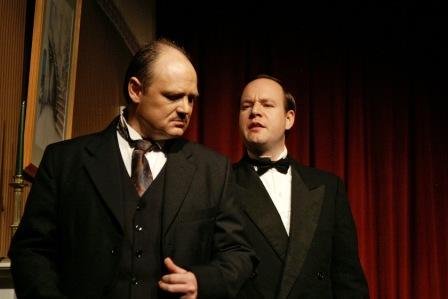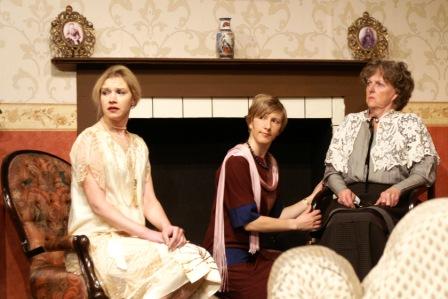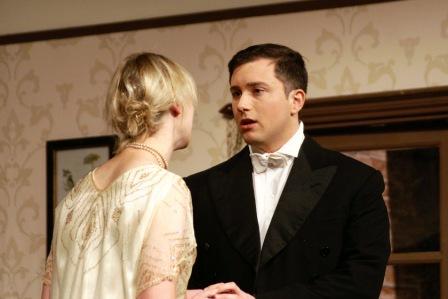|
|
|||||||||||||||||||||||||||||||||||||||||||||||||||||||||||||||||||||||||||
Click
here for more pictures of this play |
|||||||||||||||||||||||||||||||||||||||||||||||||||||||||||||||||||||||||||
|
|||||||||||||||||||||||||||||||||||||||||||||||||||||||||||||||||||||||||||
|
Click here for the
NODA crit for this play |
|||||||||||||||||||||||||||||||||||||||||||||||||||||||||||||||||||||||||||
|
The Stepmother was an interesting choice of play and has apparently never been performed in England before. Githa Sowerby, although famous for her first play ‘Rutherford & Son’ (performed in 1912) lived until 1970 with no further success. Known as an early feminist playwright perhaps the moral tone of this play was too much for post Edwardian minds. However it had a strong cast and was beautifully set, the suffocating atmospheres of Edwardian England and the new freedoms (for some) in the 20th Century well expressed (Howard Platt’s programme notes were most helpful for me to discover more about this little known play.) Garry Cooper and team designed an interesting and usable space with a lovely sense of period and atmosphere, the later Albany flat extension into the audience worked well and the quick change from house to shop premises was achieved with speed and imagination. The backstage team obviously worked hard while lighting and sound effects enhanced the good work on stage. The differences between the pre and post electricity periods were well defined. The costumes by Christine Eckley and team were excellent and enjoyable to look at. The period change between 1914 and 1924 were well defined and I particularly liked the two girls’ 1920s ball dresses. I loved Lois’ outfits in Act 2 and Act 3; one could really believe that she ran a successful dress shop. As mentioned, there was a strong cast with many delightful cameo parts – all of which were well considered and performed to their maximum potential. The two main characters of Eustace and Lois were excellently done. Eustace (played by Iain Howland) was a wonderful thorough going despicable cad! Didn’t we all hate him! An extremely strong portrayal by Iain throughout. Despite all we knew about him we could understand why Lois – who ought to have hated him too - actually had very ambivalent feelings towards him because he showed that he did have the ability to be charming. In the last but one scene he actually made us feel sorry for him! Lois (played by Lisa Maule) had an incredible difficult part to play! Not terribly helped by the stiff upper lip period in which the play was set. I think Githa was trying to show how powerless women of that time were. We’re so used to our 21st Century freedoms that we forget that in those days by law women were simply their husbands chattels and yet Lois was shown as a sensitive, loving individual who poured all her affection upon the two children she had taken on by marrying Eustace and all her energy into trying to make her business successful and keep her home running on a shoestring. Despite everything she still believed naively that her husband had kept her fortune for her and wanted to use it to benefit her beloved stepdaughter. Are we to believe that she looked for a happy marriage for her step daughter to compensate for the sterile marriage in which she found herself? Poor Lisa had to emote all these different situations and on top of that allow the audience to understand that she harboured love for the next door neighbour (a bit understated in the script but well brought out by the actors in various innuendos.) who loved her desperately in return. The two daughters Monica (Sophie Robertson) and Betty (Simone Richardson) made good use of small parts, Sophie the elder was a touch petulant but the script seemed to demand it, however she carried the part well, looked lovely, particularly in the gold dress and coped very naturally with the things that went wrong (on Saturday evening) the belt of her dress fell off and her hair decoration fell out). These things display how well in character she was. Betty, the younger as a naïve and slightly truculent teen, in an age when teens didn’t exist, showed well how little ‘clout’ all children had until they were of age. She had important lines to show that Peter was a ‘good friend of the family’ and her naïve innocence about his friendship was well observed. Mr Bennett (Foster Barnett) was a small but important part and well played. There was a nice sense of distaste for Eustace but he came across as a man who did his duty. In later scenes, with reference to his son’s marriage to Monica, we see him as a kind man who does not want to disappoint his son but needs to be sure that there is a settlement – not just for money reasons (though I think that was there) but also for reasons of security. A man of his time! Monica’s fiancé Cyril Bennett (Tom Donoghue) was a good strong performance, not too soppy, but nicely loving and reassuring to Monica. There was no sense of embarrassment which is not always easy in tender love scenes – so, well done. Turning to Peter Holland (David Stelfox), I was amazed at how David managed to let us know how much he loved Lois with so few lines. His stance and looks subtly showed the audience his wealth and his care for Lois. Not until later in the play did he really have the chance to show his strength in the scene with Eustace and it was well acted. He was ideal as the strong silent lover in background. The Director, Jean Cooper, is an experienced director and it was needed for this production – there were so many nuances and levels of emotion to be shown that to get that kind of result from the players was excellent. She had a good strong cast and I think she and her team brought out the best in them. In particular by helping those who had cameo parts to bring out the best in their performances, as well as encouraging the main parts to develop their characters so successfully. All in all this play was a wonderful example of L.A.D.S. being unafraid to tackle an unusual play and by working as a team to give their audiences a worthwhile and enjoyable evening. |
|||||||||||||||||||||||||||||||||||||||||||||||||||||||||||||||||||||||||||



